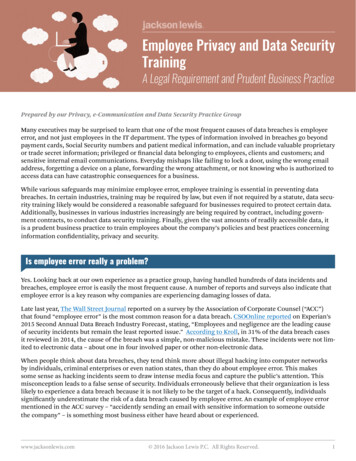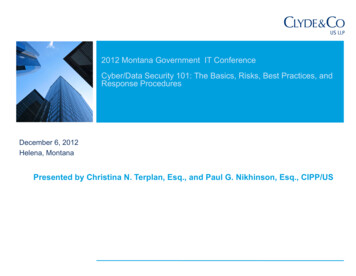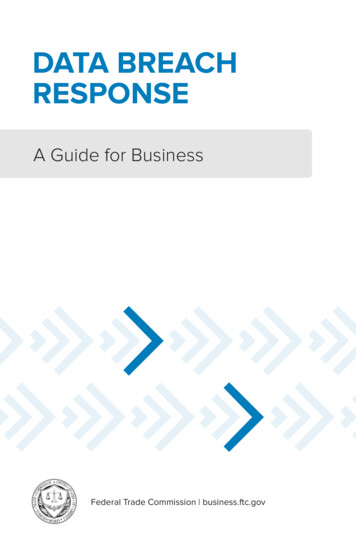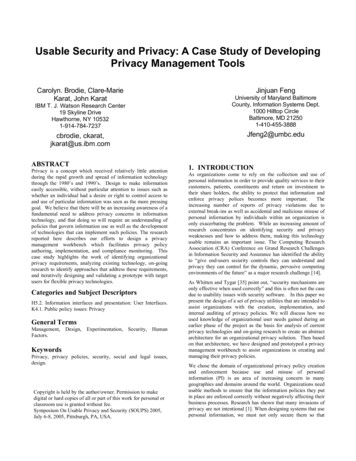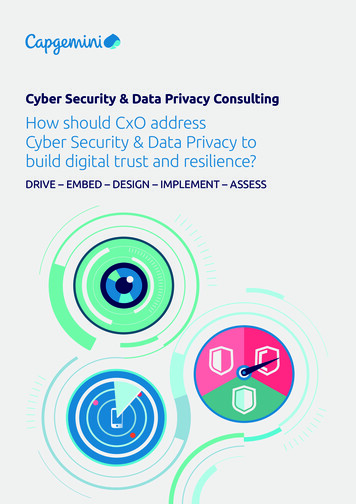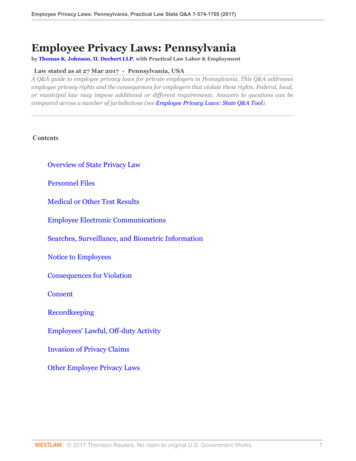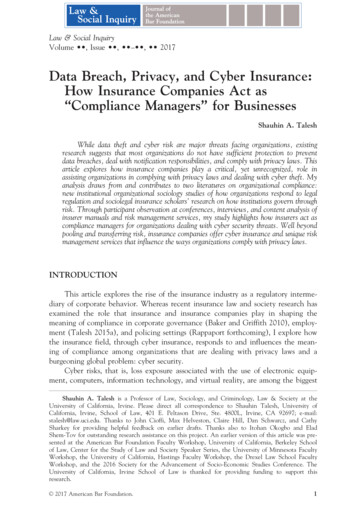
Transcription
Law & Social InquiryVolume , Issue , – , 2017Data Breach, Privacy, and Cyber Insurance:How Insurance Companies Act as“Compliance Managers” for BusinessesShauhin A. TaleshWhile data theft and cyber risk are major threats facing organizations, existingresearch suggests that most organizations do not have sufficient protection to preventdata breaches, deal with notification responsibilities, and comply with privacy laws. Thisarticle explores how insurance companies play a critical, yet unrecognized, role inassisting organizations in complying with privacy laws and dealing with cyber theft. Myanalysis draws from and contributes to two literatures on organizational compliance:new institutional organizational sociology studies of how organizations respond to legalregulation and sociolegal insurance scholars’ research on how institutions govern throughrisk. Through participant observation at conferences, interviews, and content analysis ofinsurer manuals and risk management services, my study highlights how insurers act ascompliance managers for organizations dealing with cyber security threats. Well beyondpooling and transferring risk, insurance companies offer cyber insurance and unique riskmanagement services that influence the ways organizations comply with privacy laws.INTRODUCTIONThis article explores the rise of the insurance industry as a regulatory intermediary of corporate behavior. Whereas recent insurance law and society research hasexamined the role that insurance and insurance companies play in shaping themeaning of compliance in corporate governance (Baker and Griffith 2010), employment (Talesh 2015a), and policing settings (Rappaport forthcoming), I explore howthe insurance field, through cyber insurance, responds to and influences the meaning of compliance among organizations that are dealing with privacy laws and aburgeoning global problem: cyber security.Cyber risks, that is, loss exposure associated with the use of electronic equipment, computers, information technology, and virtual reality, are among the biggestShauhin A. Talesh is a Professor of Law, Sociology, and Criminology, Law & Society at theUniversity of California, Irvine. Please direct all correspondence to Shauhin Talesh, University ofCalifornia, Irvine, School of Law, 401 E. Peltason Drive, Ste. 4800L, Irvine, CA 92697; e-mail:stalesh@law.uci.edu. Thanks to John Cioffi, Max Helveston, Claire Hill, Dan Schwarcz, and CathySharkey for providing helpful feedback on earlier drafts. Thanks also to Itohan Okogbo and EladShem-Tov for outstanding research assistance on this project. An earlier version of this article was presented at the American Bar Foundation Faculty Workshop, University of California, Berkeley Schoolof Law, Center for the Study of Law and Society Speaker Series, the University of Minnesota FacultyWorkshop, the University of California, Hastings Faculty Workshop, the Drexel Law School FacultyWorkshop, and the 2016 Society for the Advancement of Socio-Economic Studies Conference. TheUniversity of California, Irvine School of Law is thanked for providing funding to support thisresearch.C 2017 American Bar Foundation.V1
2LAW & SOCIAL INQUIRYnew threats facing businesses and consumers. Cyber security risks are crucial as consumer, financial, and health information are increasingly stored in electronic form.Hackers, malware, viruses, tracking software, wiretapping, eavesdropping, robocalls,and solicitation lead to identity theft and compromised personal, financial, andhealth information. These breaches affect virtually every major industry, including,but not limited to, financial services, health care, government, entertainment,online gaming, retail, law, insurance, social networking, and credit card processing.As people become more reliant on electronic communication and organizations collect and maintain more information about their consumers, the opportunityfor bad actors to cause problems for organizations and the public is growing exponentially. The number of data breaches tracked by the Identity Theft ResourceCenter (ITRC) in 2015 was 781, the second highest year on record since the ITRCbegan tracking breaches in 2005 (ITRC 2016). The Ponemon Institute, an independent research organization on privacy, data protection, and information securitypolicy, notes that 75 percent of organizations surveyed experienced data loss orbreach since 2014 (Ponemon Institute 2016). The Office of Civil Rights indicatedthat 112 million health-care-related records were lost, stolen, or inappropriately disclosed via data breaches in 2015 (Munro 2015). According to recent reports, theaverage cost of a data breach event for an organization is between 3 and 7 milliondollars (Podolak 2015; Lovelace 2016).1In addition to financial and public relations damage, data breach events oftenthreaten an organization’s survival. Organizations also face compliance hurdles asthey navigate between various, sometimes overlapping, federal and state laws andregulations concerning the collection and use of personal data.2 The proliferation ofsecurity breaches in the last five years has resulted in an expansion of privacy laws,regulations, and industry guidelines. The increased flow of data across state boundaries, coupled with the increased enactment of data-protection-related statutes, creates significant challenges for organizations operating at a national level to complywith the state and federal legal requirements.Even when there is no evidence that compromised data were used or otherwisedisseminated, companies are still potentially subject to notification requirements,resulting in significant costs. Forty-seven states have notification statutes thatrequire prompt notice of data breaches to those affected and to the state attorneygeneral. Moreover, many statutes impose a significant daily fine for late notice or a1. In addition, IBM’s most recent report indicated that it costs approximately 158 for every lost orstolen record. In highly regulated industries such as health care, the cost of a breach can be as much as 355per record (Lovelace 2016).2. There is no single, comprehensive federal national law regulating the collection and use of personaldata in the United States. Instead, the United States has a patchwork of federal and state laws that sometimes overlap. The major federal laws that regulate privacy in different ways include, but are not limited to,the Federal Trade Commission Act, the Financial Services Modernization Act, the Health Insurance Portability and Accountability Act, the Fair Credit Reporting Act, and the Electronic Communications PrivacyAct. There are many laws at the state level that regulate the collection and use of personal data. Some federal privacy laws preempt state privacy laws on the same topic. For example, the federal law regulating commercial e-mail and the sharing of e-mail addresses preempts most state laws regulating the same activities.However, there are many federal privacy laws that do not preempt state laws, which means that a companycan find itself in the position of trying to comply with federal and state privacy laws that regulate the sametypes of data or types of activity in slightly different ways.
Data Breach, Privacy, and Cyber Insuranceprivate right of action for failure to comply. Finally, as the number of data breachesgrows, so does the number of individuals pursuing legal action to remedy theirinjuries.3Despite legal, reputational, financial, and survival threats, prevailing researchsuggests that private organizations are not significantly changing their behavior.Although many organizations do have formal policies in place, the majority oforganizations do not believe they are sufficiently prepared for a data breach, havenot devoted adequate money, training, and resources to protect consumers’ electronic and paper-based information from data breaches, and fail to perform adequate risk assessments (Business Wire 2015; Ponemon Institute 2015, 2016). Infact, because complying with multiple security frameworks is difficult, time consuming, and expensive, many organizations express “compliance fatigue” (Armerding2015).Recognizing this underpreparation and undercompliance gap, the insurancefield stepped in during the last decade and began offering cyber insurance. Cyberinsurance is insurance designed to provide both first-party loss and third-party liability coverage for data breach events, privacy violations, and cyber attacks.Although there is variation in the types of policies being offered, insurers offeringcyber insurance provide some risk shifting for the costs associated with having torespond, investigate, defend, and mitigate against the consequences surrounding acyber attack.Compared to other lines of insurance, cyber insurance is in its infancy. Therefore, there is limited data on how competitive the cyber market is. However, we doknow the cyber insurance market is growing rapidly as organizations become moreaware of its potential usefulness. Whereas most companies did not have cyber insurance a decade ago, one in three organizations now has insurance specifically protecting against cyber and data theft losses (Fernandes 2014; Business Wire 2015).4The insurance industry’s most recent reports, issued in 2015, indicate that 120insurance groups are writing cyber insurance in the United States, totaling approximately 1 billion in direct written premiums with a loss ratio of 65 percent (Business Wire 2016).5 Recent estimates suggest that the global insurance marketcollected approximately 2 billion in cyber insurance premiums and that this willrise by a magnitude of three to five times by 2020 (Business Wire 2016). Cyberinsurance, therefore, is one of the biggest areas of growth among insurers, andorganizations, in turn, are increasingly purchasing cyber insurance to deal withthese new risks.3. Different legal theories used by victims of data breach include (1) common law tort and contractclaims, (2) constitutional privacy claims, (3) state and federal statutory claims, and (4) failure to notifyclaims under state data breach notification statutes.4. In 2013, cyber insurance policies sold to retailers, hospitals, banks, and other businesses rose 20 percent according to Marsh LLC, a New York insurance brokerage firm that tracks the market (Fernandes2014).5. For insurance, the loss ratio is the ratio of total losses incurred (paid and reserved) in claims plusadjustment for expenses divided by the total premiums earned. Thus, if the loss ratio is 65.2 percent, itmeans that for every 100 million collected in premiums, the insurance companies are paying out approximately 65 million to policyholders.3
4LAW & SOCIAL INQUIRYDespite the increased attention on data theft and cyber insurance, there hasbeen little research directed toward the role that insurance and, in particular, insurance institutions play in constructing the meaning of compliance with privacy lawsand dealing with data breach. Drawing from participant observation and ethnographic interviews at cyber insurance conferences across the country, in addition tocontent analysis of cyber insurance policies, loss prevention manuals, cyber insurance risk management services, and webinars, my data suggest that insurance companies and institutions, through cyber insurance, go well beyond simply pooling andtransferring an insured’s risk to an insurance company or providing defense andindemnification services to an insured; rather, my data suggest that cyber insurersare also acting as compliance managers.By offering a series of risk management services developed within the insurance field, insurance institutions actively shape the way organizations’ variousdepartments tasked with dealing with data breach, such as in-house counsel, information technology, compliance, public relations, and other organizational units,respond to data breaches. Cyber insurance provides a pathway for insurance institutions to act as external compliance overseers and managers of organizational behavior with respect to data theft. Given the underpreparation and compliance bybusinesses, I conclude that institutionalized risk management techniques developedwithin the insurance field can potentially improve organizational practices andcompliance concerning data breach, but may have some potential drawbacks aswell.RISK-BASED AND NEW INSTITUTIONAL APPROACHES TOWARDSTUDYING ORGANIZATIONAL COMPLIANCE WITH LAWConsistent with the global turn away from command-and-control regulationand toward more public-private partnerships and self-regulation, insurance scholarsare increasingly discussing the role of private insurance as a form of regulation overindividuals and organizations (Ben-Shahar and Logue 2012; Talesh 2015b). Insurance policies often take the form of private legislation or regulation through a widevariety of exclusions and conditions. To that end, insurance companies play animportant role by shaping policy language and also communicating ideas aboutwhat law means to organizations tasked with complying with and implementingvarious legislative and regulatory mandates. Broadening this frame, Baker andSimon explore how institutions address compliance concerns by “governing throughrisk” or “[using] formal considerations about risk to direct organizational strategyand resources” (Baker and Simon 2002, 11). This concept includes not only the useof risk-based principles by insurance companies, but also the use of insurance technologies and concepts to govern risk outside of insurance institutions (Baker andSimon 2002; Ewald 2002; Heimer 2002).In particular, scholars examining these issues across a variety of contexts notethat insurance develops templates to regulate behavior in ways that are potentiallymore precise than some forms of governmental control (Ben-Shahar and Logue2012). Through policy language, pricing, and risk management services, liability
Data Breach, Privacy, and Cyber Insuranceinsurance companies actively engage in loss prevention and try to influence thebehavior of actors and organizations (Heimer 2002; Ericson, Doyle, and Barry 2003;Baker 2005; Baker and Griffith 2010; Ben-Shahar and Logue 2012; Abraham2013). Insurers, and insurer risk management techniques, manage moral hazard inproperty and fidelity relationships (Heimer 1985), govern security in the home(O’Malley 1991), impact the motion picture industry in the United States (Hubbart199621997), influence risk management approaches toward campus drinking(Simon 1994), and encourage better policing practices (Rappaport forthcoming).Recent work in this area pivots away from how policy language acts as a formof regulation to focusing on the processes and mechanisms through which insurersengage in risk regulation and the extent to which insurance institutions influenceor induce compliant behavior with laws and regulations. Here, empirical findingsare much more mixed; although insurers offering directors and officers insurancehave an opportunity to influence the behavior of directors and officers and discourage wrongful or even illegal behavior, they seldom do (Baker and Griffith 2010).6More recently, insurance scholars have drawn from new institutional organizational sociology studies to explain how insurance institutions mediate the meaningof compliance through a logic of risk operating within the insurance field. Priornew institutional research reveals how managerial conceptions of law anchoredaround concepts of rationality, efficiency, and discretion broaden the term diversityin a way that disassociates the term from its original goal of protecting civil rights(Edelman, Fuller, and Mara-Drita 2001), transform sexual harassment claims intopersonality conflicts (Edelman, Erlanger, and Lande 1993), deflect or discouragecomplaints rather than offering informal resolution (Marshall 2005), and evenshape the way public legal institutions such as legislatures (Talesh 2009, 2014),courts (Edelman, Uggen, and Erlanger 1999; Edelman 2005, 2007; Edelman et al.2011), and arbitration forums (Talesh 2012) understand law and compliance. Drawing from new institutional studies, I show how the insurance field frames the legalenvironment of employers around concerns of risk (Talesh 2015a,b).For example, through employment practice liability insurance (EPLI), insurance companies play a critical and as yet unrecognized role in mediating the meaning of antidiscrimination law (Talesh 2015a,b). Faced with uncertain legal riskconcerning potential discrimination violations, insurance institutions elevate therisk and threat in the legal environment and offer EPLI and a series of risk management services that build discretion into legal rules and mediate the nature of civilrights compliance. In this setting, risk and managerial values work in a complementary manner because the insurance field uses risk-based logics to encourage employers to engage in managerial responses such as developing policies and procedures.76. Directors and officers liability insurance (often called “D&O”) is liability insurance payable to thedirectors and officers of a company, or to the organization itself, as reimbursement for losses or advancementof defense costs in the event an insured suffers such a loss as a result of a legal action brought for allegedwrongful acts in his or her capacity as a director and/or officer.7. Although there are a few new institutional studies in this area that frame risk in terms of litigationthreat, new institutionalists have yet to engage in a comprehensive exploration of the processes throughwhich risk narratives influence the meaning of compliance (Edelman, Abraham, and Erlanger 1992; Dobbinet al. 1993; Schneiberg and Soule 2005; Edelman 2016).5
6LAW & SOCIAL INQUIRYThis study continues in this recent tradition of marrying new institutionalstudies of compliance and sociolegal studies of risk and moves into an area largelyunexplored by scholars: privacy law and data theft. Prior research in this areafocuses on the role that privacy officers play in shaping compliance with privacylaw without focusing on cyber insurance and the role that insurance companiesplay as managers of the compliance behavior of organizations (Bamberger and Mulligan 2015). My study bridges the new institutional and insurance and risk literatures. In particular, I import the governing through risk approach into newinstitutional studies of law and organizations by revealing how risk managementservices and risk-based logics that are institutionalized within the insurance fieldinfluence what organizations are told privacy laws mean and how they are told torespond to data breaches.METHODOLOGYMy research design evaluated how, through cyber insurance, participants inthe insurance field, that is, insurance companies, claims administrators, brokers,agents, risk management consultants, underwriters, product managers, in-housecounsel, and insurance attorneys, respond to data breach issues and influence themeaning of compliance with cyber security and privacy laws. A series of subquestions guided my inquiry: (1) How does the insurance industry shape the way thatorganizations respond to data theft breaches and the accompanying privacy laws?(2) How does the insurance industry characterize the objectives of privacy laws? (3)How does the insurance industry characterize the problem of data theft (cyber security)? and (4) How do formal considerations of risk impact the way that the insurance field responds to cyber security threats?To answer these questions, I gained entry into the emerging field of cyberinsurance, which is not easily accessible to social science research. I used differentsources of data from a variety of locations.8 Obtaining data from a variety of sources (participant observation, interviews, and content analysis) was particularlyimportant because I was trying to map an aspect of the insurance field, cyberinsurance, that is largely nascent and in its early stages of development. Because Ido not have data on how cyber insurance impacts actual organizational behavior,or whether cyber insurance and the risk management services that insurers offerlead to less data theft, my data focus is on how the insurance field frames compliance with privacy laws and how it attempts to prevent data theft fromorganizations.98. Because unfettered access was unrealistic and preliminary inquiries revealed that industry officialswere resistant to formal in-depth interviews, I triangulated through participant observation, ethnographicinterviewing, and extensive content analysis.9. Despite these limitations, the increasing purchase of cyber insurance by organizations and theplethora of insurer risk management tools that are emerging and examined by this study and my fieldworksuggest, at least preliminarily, that organizations are finding insurer-based compliance management useful.
Data Breach, Privacy, and Cyber InsuranceParticipant Observation at Cyber ConferencesI attended four national conferences on cyber insurance over a period of twoyears. Cyber conferences are three days long, occur two to three times a year, andbring together various actors engaged in employment practices liability to discussimportant issues in the field. These conferences have been occurring for approximately ten years. Cyber conferences are where the majority of actors involved indrafting, marketing, buying, and selling cyber insurance engage one another. Cyberconferences allowed me to observe the field and to explore how various organizational actors think about data breaches and privacy laws, to document what logicsor frames were dominating the discourse as participants discussed cyber insurance,and to explore how field actors use and market cyber insurance as a mechanismthrough which organizations can better comply with privacy laws.Cyber liability insurance conferences were typically held at hotels. Approximately fifty to seventy-five insurance field actors attended these conferences. Panelsessions occurred daily and brought attendees together in one conference room.10 Iobserved approximately thirty-one panel sessions on cyber insurance. Conferencerooms were set up much like classrooms, with a podium and table for discussants inthe front of the room and rows of tables and chairs for audience members.WebinarsI also observed, transcribed, and coded cyber insurance webinars administeredby risk management consultants and brokers, insurance industry and cyber securityexperts, and attorneys. These webinars simultaneously market cyber insurance andeducate webinar participants on what cyber insurance is, educate participants onhow cyber insurance is used, and highlight the various risk management servicesthat are provided to organizations that purchase cyber insurance. Similar to conferences, cyber insurance webinars allowed me to explore how various organizationalactors discuss the interplay between insurance, data theft, and privacy laws.Content Analysis from Primary Sources: Cyber Insurance Policies and RiskManagement ServicesUnlike most lines of insurance, insurance companies offering cyber liabilityinsurance also offer accompanying risk management services to address a wide variety of problems that organizations experience when data breaches occur. Cyberinsurers rely heavily on offering organizations either the risk management servicesthey have or the services of third-party vendors with whom they contract. Ireviewed over thirty different risk management services offered by insurers andthird-party vendors. These data proved to be a key area of focus for this researchproject. Researching the risk management services was important because it10. There was never more than one panel session going on at a time.7
8LAW & SOCIAL INQUIRYrevealed how the insurance industry acts as a compliance manager well beyond thetraditional services that the insurance industry offers. I also reviewed industryreports and executive summaries by risk management consultants who conductresearch on the kinds of cyber liability insurance coverage offered by insurers. Inaddition to these reports, I also obtained and evaluated cyber insurance policies.While most EPLI policies have similar provisions, some vary with respect to thetype of specific first- and third-party coverage offered.Ethnographic InterviewsMy observations at the annual cyber conferences allowed me to identify various field actors and to pursue informal, ethnographic interviews. Ethnographicinterviewing is a type of qualitative research that combines immersive observationand directed, one-on-one interviews (Spradley 1979). Because these interviewsoccur in the interviewees’ natural settings while they are performing their normaltasks, the interviews are less formal. While at the conferences, I conducted twentytwo ethnographic interviews with field actors. These interviews varied in lengthfrom five to thirty minutes and generally involved eliciting opinions about theinterplay between cyber insurance and various privacy laws from (1) insuranceagents, (2) brokers, (3) claims administrators, (4) insurance company executives,and (5) attorneys.CodingFollowing standard procedures and protocols for qualitative research, dataanalysis proceeded from coding, to developing conceptual categories based on thecodes, to defining the conceptual categories, and, finally, to clarifying the linksbetween the conceptual categories (Fielding 1993; Charmaz 2001; Lofland et al.2005). I first open coded (Lofland et al. 2005). Under this coding approach, written data from field notes and insurance industry documents were coded line byline (Charmaz 2001). I initially created some preliminary substantive coding categories around actors encountered in the field, activities observed in the field, andvariation in written cyber security materials produced by insurance actors. Focusedcoding (Charmaz 2001) led me to refine my coding into analytic categories andto identify how risk-based principles and values filter the way that insuranceactors discuss compliance with privacy laws. To add a layer of formality, transparency, and systematization to my coding process, I used qualitative coding software(ATLAS.ti) to code my written materials, interviews, and field notes (Fielding1993).While no one method used in this study provides enough data to reveal conclusive findings, I am confident that triangulating across multiple sites and examining different data points led to reliable findings. Unlike prior studies of insurance asregulation and insurer risk management, I am studying a field that is largely immature and changing in real time. Insurance scholars, therefore, would benefit from
Data Breach, Privacy, and Cyber InsuranceFIGURE 1.How the Insurance Field Influences the Meaning of Compliance with PrivacyLaw and Cyber Security Threats [Color figure can be viewed at wileyonlinelibrary.com]replicating this study in another ten years to see to what degree insurer risk management in this area has evolved and to what degree such techniques are impactingorganizational responses to data breaches and privacy law more generally.INSURANCE INSTITUTIONS AS COMPLIANCE MANAGERS OFDATA THEFT BREACHES AND PRIVACY LAWSThe following explores how insurance companies and institutions, throughcyber liability insurance, actively shape the way an organization’s various departments tasked with dealing with data breach, such as in-house counsel, information technology, compliance, public relations, and other organizational units,respond to data breach. I find that cyber insurers are acting as compliance managers aimed at preventing, detecting, and responding to data breaches and complying with various privacy laws. Through policy language and risk managementservices, insurance companies and the third-party vendors with whom they contract to assist insureds absorb the responsibilities of the legal counsel, compliance,public relations, and information technology departments for organizations with aseries of additional risk management services. Figure 1 highlights how insurancecompanies shape the nature of compliance through expansive policy coverageand risk management services. In addition to policy language, the insurance fielduses a series of mechanisms aimed at preventing, detecting, and responding todata theft.Cyber Insurance—Beyond Risk Transfer of Defense and ExpensesAnalysis of various cyber insurance policies reveals that this insurance is animportant intervention in the insurance market because it expands coverage toinsureds for losses specifically excluded by other lines of insurance. Whendata breach issues arose about a decade ago, policyholders fought, largely9
10LAW & SOCIAL INQUIRYunsuccessfully, with commercial general liability (CGL) and property insurers overcoverage.11 Modern CGL policies specifically exclude electronic data from the definition of property damage, which means that the only form of coverage that CGLpolicies can provide is associated with liability from physical damage to hardware,which is unusual in most cyber incidents. Property insurance and other lines ofinsurance also exclude coverage for losses associated with data breach.Cyber insurance eliminates potential denials of coverage that often occur underother lines of insurance and provides a source of risk transfer. Cyber insurance is similar to homeowner and automobile insurance and some other lines of insurancebecause it covers a very broad scope of losses. In particular, cyber insurance policiesprovide both first-party coverage (the policyholder insures her own interest in herbody or property) and third-party coverage (which pays proceeds to a third party towhom an insured becomes liable) for data breach events. Thus, cyber insurance oftencovers the loss of personal information regardless of how the data were lost or stolen.Although the scope and breadth of coverage varies among insurers, this insurancetries to shift ri
risk" or "[using] formal considerations about risk to direct organizational strategy and resources" (Baker and Simon 2002, 11). This concept includes not only the use of risk-based principles by insurance companies, but also the use of insurance tech-nologies and concepts to govern risk outside of insurance institutions (Baker and

